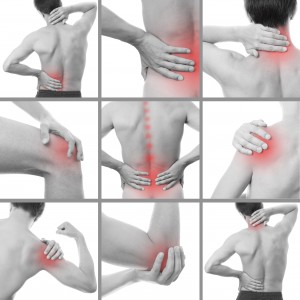
Medically unexplained physical symptoms (MUPS) is a label used to describe physical symptoms for which adequate evidence regarding the presence of an underlying pathophysiological process is absent following appropriate examination and investigation.
MUPS are very common in healthcare settings, and in fact almost one third of all people presenting with physical symptoms have MUPS (Kirmayer et al., 2004). Also, the presence of MUPS is a key feature of conditions included in the diagnostic category of “somatoform disorders”.
In a recent Cochrane Systematic Review, van Dessel and colleagues give an overview of the evidence for non-pharmacological interventions for MUPS and somatoform disorders.

Medically unexplained symptoms (MUPS) are very common in healthcare settings.
Methods
The authors included randomized clinical trials (RCTs) and cluster RCTs involving adults who were primarily diagnosed with a somatoform disorder, or who were characterized with MUPS (assessed with a validated scale), as their primary problem. Studies in which participants were diagnosed with one specific functional syndrome or symptom (e.g., fibromyalgia) were excluded.
Patients had to be assigned to a non-pharmacological intervention (psychological or physical therapies), which had to be compared with usual care, waitlist control, attention or psychological placebo, enhanced or structured care, or another psychological or physical therapy intervention, alone or in combination.
Primary outcome measures were
- Severity/intensity of somatic symptoms (assessed primarily with validated scales and, in the case none was available, with multiple visual analogue or non-validated scales)
- Acceptability of treatment (assessed as the complement of the proportion of trial participants who dropped out from either the experimental or the comparator group)
Secondary outcomes included: depression and anxiety; dysfunctional cognitions, emotions or behaviors (participant rated); adverse events; treatment response (responder versus non-responder); functional disability and quality of life; healthcare use.
Outcomes were analysed at the following time points (when available):
- Post-treatment
- Within 12 months after the end of treatment
- More than 12 months after the end of treatment
Included studies were assessed for methodological quality, using the following criteria from the Risk of Bias Assessment tool developed by Cochrane Collaboration: random sequence generation, allocation concealment, blinding of participants and study personnel, blinding of outcome assessors, incomplete outcome data, selective outcome reporting, other sources of bias. Moreover, the authors also evaluated treatment fidelity, researcher allegiance and therapist qualifications.
Effect sizes (ES) were calculated as standardized mean differences for continuous data or by risk ratios for dichotomous data.
Results
21 studies met the inclusion criteria and were included in the meta-analysis. Only one of these was a cluster RCT. All studies investigated the efficiency of some form of psychotherapy. Out of these, two thirds (14 studies) investigated forms of cognitive behavioral therapy (CBT). No study examined physical therapy.
- Risk of bias was high for most studies for the criteria regarding blinding (participants, therapists, outcome assessors), but this was also due to the nature of the interventions. With most psychological interventions, it is impossible to ensure blinding of participants and therapists. For the other criteria considered, risk of bias was low.
- Adverse events were rarely reported.
- Psychological therapy resulted in less severe symptoms at the end of treatment (SMD= -0.34, 95% CI -0.53 to -0.16) compared to usual care or a waitlist. However, the overall quality of evidence for this comparison was low
- Psychological therapies resulted in a 7% higher proportion of drop-outs during treatment than usual care.
- When the analysis was restricted to CBT, results were similar, both for symptom severity, as well as for drop-out.
- Psychological therapy was not different from enhanced care for symptom severity assessed at the end of treatment, but this comparison was based on only five studies and their overall quality was low. However, psychological therapies were less acceptable than enhanced care in term of drop-outs.
- Psychological therapies were more efficient for symptoms of anxiety and depression than usual care and waitlist at the end of treatment, but only when symptoms were assessed on clinician-based and not self-report measures. These results were based on a small number of studies, only 3 for anxiety, and 6 for depression.

Psychological therapies for MUPS led to reduced symptom severity, but were associated with a higher drop-out rate than usual care.
Conclusions
The authors concluded that:
All psychological therapies combined were superior to usual care or waiting list condition for symptom severity, our first primary outcome, but effect sizes were small. As a single treatment, only cognitive behavioural therapy (CBT) was adequately studied to allow conclusions for practice.
However, they also emphasized that:
In daily practice, a substantial percentage of people with medically unexplained physical symptoms (MUPS) may not be willing to accept psychologically oriented treatments. Whether such acceptance is associated with the effect of psychological treatments for the total MUPS population was not clear.
The authors underscored that the quality of the evidence on which the review was based was low to moderate. They also drew attention to the fact that the reduced number of studies included in the review prevented them from analyzing and drawing conclusions about the impact of characteristics such as the therapist’s profession and experience, treatment intensity or location, on the efficacy of the interventions.

A substantial proportion of individual with MUPS may not be willing to accept psychological treatments.
Limitations
- The number of included studies was small, and consequently many comparisons were based on a very small number of effect sizes, making results extremely volatile and precluding the authors from drawing firm conclusions or implications for practice.
- The reduced number of studies effectively prevented the analysis of publication bias for most comparisons, since funnel plots could not be constructed with so few points.
- Heterogeneity was a problem for most comparisons, again making results unstable and difficult to interpret.
- The overall quality of the studies included in the review was low.
Links
Van Dessel, N., den Boeft, M., van der Wouden, J.C., Kleinstäuber, M., Leone, S.S., Terluin, B., Numans, M.E., van der Horst, H.E., van Marwijk, H., 2014. Non-pharmacological interventions for somatoform disorders and medically unexplained physical symptoms (MUPS) in adults. Cochrane Database Syst Rev 11, CD011142. doi:10.1002/14651858.CD011142.pub2
Kirmayer, L.J., Groleau, D., Looper, K.J., Dao, M.D., 2004. Explaining medically unexplained symptoms (PDF). Can J Psychiatry 49, 663–672.


RT @Mental_Elf: Psychotherapy for medically unexplained physical symptoms http://t.co/o5gQVsP58t
Psychotherapy for medically unexplained physical symptoms. Psychological treatments linked with high drop out. http://t.co/IYg19pxU4W
Psychotherapy for medically unexplained physical symptoms: Ioana Cristea reviews a recent Cochrane systematic … http://t.co/n56yERQsKF
Olivia Cialdi liked this on Facebook.
CBT (especially) helps with medically unexplained symptoms – challenge is to get patients to accept this kind of help http://t.co/ovSpG17Zua
“@Mental_Elf: Psychotherapy for medically unexplained physical symptoms http://t.co/AkLFvIcvoG” worth reading
Shelley Louise liked this on Facebook.
Vishal Bhavsar liked this on Facebook.
Today @Zia_Julia on a @Cochrane_CCDAN review of non-drug treatment for somatoform disorders & MUPS http://t.co/o5gQVsP58t
Sarah InStokenchurch liked this on Facebook.
SR finds psychotherapies for MUPS led to reduced symptom severity, but were assoc w/ more drop-outs than usual care http://t.co/o5gQVsP58t
The Mental Elf liked this on Facebook.
More research needed to ascertain the benefits of talking therapies for medically unexplained physical symptoms http://t.co/o5gQVsP58t
Psychotherapy for Medically Unexplained Symptoms
http://t.co/KL9mXHtutb @Mental_Elf
Dealing w uncertainty
http://t.co/vAD1pTuuyP
@AllenFrancesMD @Mental_Elf Nice job leaving out how I changed the world and how easily the Bipolar spectrum can be diagnosed now.
@AllenFrancesMD @Mental_Elf My glass is half-full. I can’t speak for your glass.
@AllenFrancesMD @Mental_Elf As we have both written elsewhere, Somatic Symptom Disorder is medically unsafe and scientifically unsupported.
@AllenFrancesMD @Mental_Elf hmm, living in Holland I know better than to trust this publication: http://t.co/ySNqO9O3FP :-///
@AllenFrancesMD @Mental_Elf they could (should!) have done a proper check on *patient*-records (and find the *lack* of med examinations!)
.@AllenFrancesMD @Mental_Elf :-( MUPS (or OLK in Dutch) has been (ab)used as cover-up for lousy med. work for decades on end in Holland :-((
RT @Mental_Elf: CBT may help ppl w/ medically unexplained physical symptoms, but acceptability of psychological treatment in doubt http://t…
” a substantial percentage of people with medically unexplained physical symptoms (MUPS) may not be willing to accept psychologically oriented treatments.”
Seeing as they seem to be ineffective, I’d have hoped that most patients would not be willing to spend their time upon them.
I think it’s time for those who have been developing and promoting psychological treatments for MUPS to drop the spin about patient’s unreasonable and stigmatizing rejection of psychological treatments, and instead acknowledge that it seems they’ve built their careers on interventions no more respectable than homeopathy.
Where patients have been encouraged to pursue these interventions based upon claims of efficacy that did not explain potential problems with things like response bias in open label trials relying on self-report measures as outcomes, then they have a legitimate reason for distrusting medical professionals encouraging psychological treatments.
RT @Mental_Elf: Don’t miss: Psychotherapy for medically unexplained physical symptoms http://t.co/o5gQVsP58t #EBP #MUPS
MT @Mental_Elf: Don’t miss: P/therapy for unexplained symptoms http://t.co/2quy6fiOtH #MUPS. My dx last week would have been #MUPS yrs ago.
Psychotherapy for medically unexplained physical symptoms http://t.co/ni0qxYfjO8 via @sharethis
Cochrane struggle to find good evidence @Mental_Elf: Psychotherapy for medically unexplained physical symptoms http://t.co/O86L34f5SK
@LiaisonLawson @AlexBThomson @Mental_Elf Or ‘Cochrane find evidence that psychotherapy is better than enhanced care’
@Herne_TheHunter @AlexBThomson @Mental_Elf but evidence quality very low – validity queried by Cochrane
@LiaisonLawson @AlexBThomson @Mental_Elf They say ‘low to moderate’ at 1 point & then ‘low’ later on. The dominance of CBT also problematic
Andy Humphries liked this on Facebook.
Sam Ingram liked this on Facebook.
Anamaria Vancea liked this on Facebook.
Christina Armstrong-Graham liked this on Facebook.
[…] post Psychotherapy for medically unexplained physical symptoms appeared first on The Mental […]
RT @Mental_Elf: New @Cochrane_CCDAN review finds no trials of physical therapy for medically unexplained physical symptoms. Why? http://t.c…
More research needed into psychological interventions for MUPS http://t.co/cQGkYobP3W